Simple rangoli design is a delightful way to infuse Indian culture into your home decor. These decorative artworks, crafted from vibrant powders, rice, flour, or sand, grace homes during festivals and special occasions in India. This ancient art form uses colourful powders, flowers, or other materials to create intricate patterns on floors and grounds, adding beauty to spaces during religious and festive events.
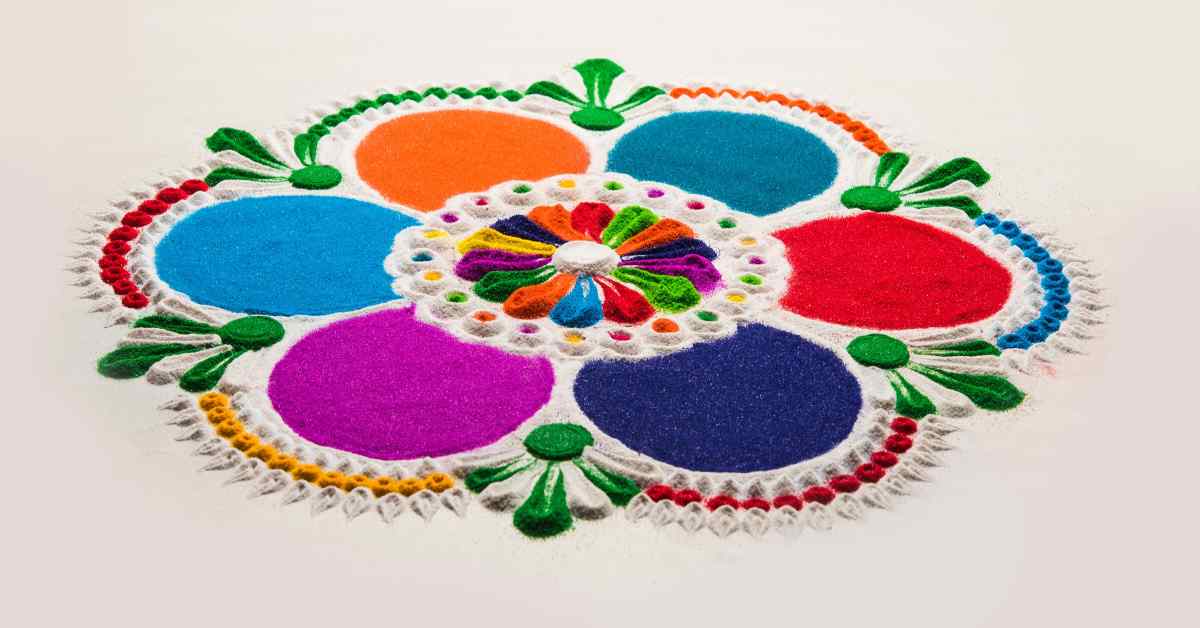
Things we covered for you
Beyond aesthetics, crafting rangoli designs offers therapeutic benefits. Whether you seek to add vibrancy to your home or unwind creatively, dive into the world of simple rangoli design. In this blog, let’s explore various types and share design tips, catering to rangoli enthusiasts of all levels.
10 Different Types of Rangolis
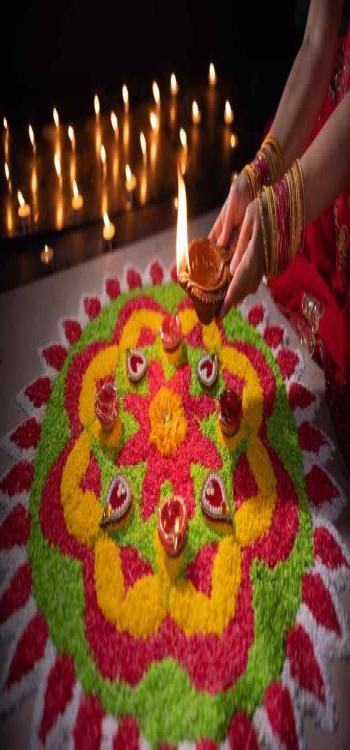
There are many types of rangoli, each with its unique design. Below are 10 of the most popular types of rangoli:
1. Dot Rangoli:
Many different designs can be used to create a rangoli, but one of the most popular and easy to do is the dot rangoli. Rangoli designs simple for homes with dots are created by placing dots of colour on the floor in a predetermined pattern and then connecting the dots with lines.
Read: DIY Memo/ Bulletin boards
First, you will need to make dots on the floor in whatever pattern you like. Then, once you have made your dots, you can start to create your design by connecting the dots in whatever pattern you like. Once you have finished creating your design, you will need to allow the dots to cool and harden. Once they are hard, your dot rangoli is complete.
2. Geometric Rangoli:
One type of rangoli that is particularly popular is geometric rangoli. It is a simple and easy rangoli design for home and as the name suggests, these designs are based on geometric shapes and patterns. They can be quite simple, or they can be very complex and detailed.
Geometric rangolis are often created using a grid system. First, the design is drawn out on paper, and then the grid is used to transfer the design onto the floor. Once the basic outline is complete, more detailed patterns are added within the space created by the grid.
3. Sand Art Rangoli:
Sand art rangoli is a beautiful and unique twist on the traditional rangoli art form. Instead of using rice or flour, coloured sand is used to create stunning designs. Sand art rangoli is a great way to add colour to your home décor.
Creating sand art rangoli is a fun and relaxing activity for people of all ages. The best part about sand art rangoli is that there are no rules–you can let your imagination run wild.
4. Rice Flour Rangoli:
Rice flour rangoli is a popular type of rangoli in India. It is made by mixing rice flour with water to create a paste. This paste is then used to create designs on the floor or ground. Rice flour rangoli is a great way to add colour and beauty to your home décor.
Rice flour rangolis are made using rice flour to create designs on the ground. Rice flour rangolis are a bit more complex than line or geometric rangolis, but they can be just as beautiful.
5. Flower Rangoli:
Flower rangolis can be created using fresh or artificial flowers. If you’re using fresh flowers, it’s important to choose ones that are not too fragile or delicate. Roses, daisies, and marigolds are all good choices. You’ll also need to make sure the flowers are fresh and haven’t started to wilt. Once your flower rangoli is complete, enjoy it for as long as it lasts.
Read: Living Room Bar Ideas to Elevate Your Home Aesthetics
6. Candle Wax Rangoli:
Candle wax rangoli is a great way to add a touch of beauty to your home décor. You can use any candle wax colour to create your design, and the process is relatively simple. First, you must melt the wax in a pot or container. Once the wax is melted, you can start to create your design by dripping the wax onto the floor in whatever pattern you like.
You can use a variety of objects to create interesting shapes & patterns and let your imagination run wild. After completing your design, you’ll need to allow the wax to cool and harden. Once it is hard, your candle wax rangoli is complete.
7. Intricate Pattern of Kundan:
Beads of all colours were used to carve this one-of-a-kind Kundan rangoli pattern. These beads are arranged in a Rangoli-like pattern on the floor. It is the work of an artistic individual. These beads can be readily removed off the floor as they are stuck with paste glue. Planting Diyas in the middle of the Rangoli design is another way to brighten it up. It will enhance the beauty of the Rangoli.
Read: The Best Kitchen Cupboard Designs for 2024
8. Rangoli that floats:
This particular style of rangoli is a treat for the eyes because it consists of diyas, flowers, and candles all floating in water in a large bowl. Get some large bowls, fill them with water, and adorn the water with floating rangoli designs if you’re different from the type of person who likes to spend a lot of time meticulously drawing out a rangoli using the typical sand colours. Establish a routine and continue carrying it out until you get to the conclusion. Your festive celebrations are likely to be more stunning with the addition of flowers and lights.
9. Freehand Rangoli:
Freehand rangolis are created without the use of stencils or predefined patterns. They allow for artistic freedom, where individuals can use their creativity to draw unique and intricate designs directly on the floor or ground. Freehand rangolis often showcase personal artistic expression and are a favourite among rangoli enthusiasts.
10. Kolam Rangoli:
Kolam is a traditional rangoli art form originating in South India. It involves creating intricate and symmetrical patterns using rice flour or chalk. Kolam are simple rangoli designs for home that are easy & beautiful and are characterised by their mathematical precision and are often drawn in front of homes as a sign of welcome and prosperity. They are an integral part of South Indian culture and traditions.
Read: 10 Village Single Floor Home Front Designs to Inspire Your Next Build
Best Rangoli Designs to Make at Home
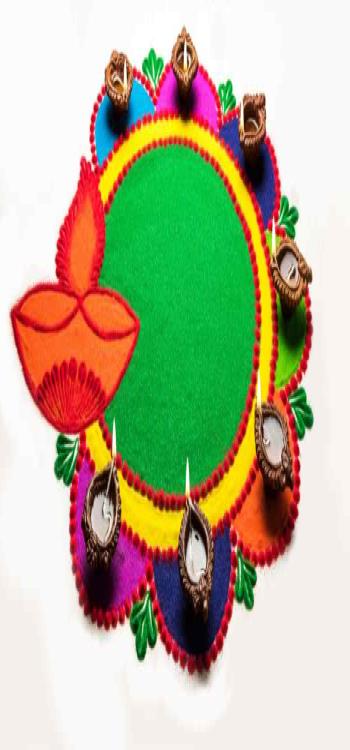
There are countless rangoli designs to choose from, but here are some of the most popular and visually stunning:
The Lotus Design
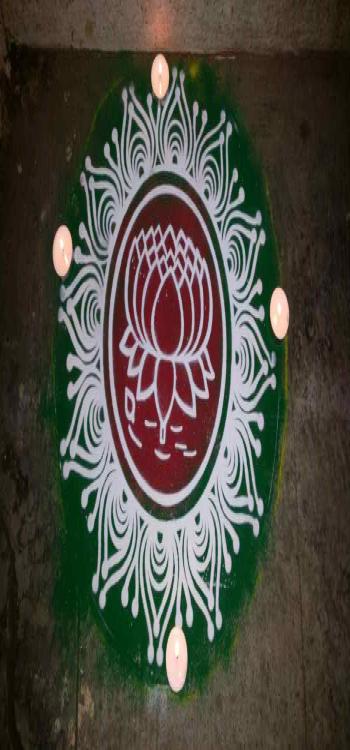
One of the best rangoli designs which is easy to make is the lotus design that symbolises beauty, purity and grace. It is typically created using white powder or flower petals but can also be made using colourful powders for a more vibrant look.
Step-to-step guide to making The Lotus Design
- Firstly, you must draw a small circle in the centre of your intended rangoli area. This will be the centre of your lotus design.
- Once you have drawn the central circle, start drawing petals around it. You can make as many or as few petals as you like, but typically, lotus designs have between 4 and 8 petals.
- Once you have finished drawing thepetals, start filling the space between them with smaller circles or dots.
- Once you have filled in all the spaces, your Lotus design is complete! You can add any additional decoration, such as coloured powders or stones.
The Peacock Design
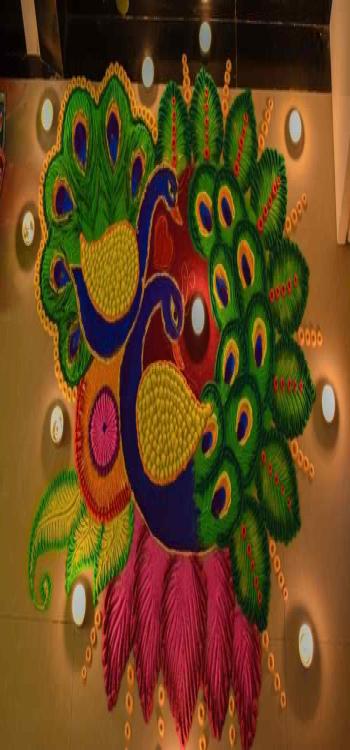
The peacock is said to represent pride, confidence and beauty. Peacock is a simple rangoli design with colours which usually made using blue, green and yellow powders or petals but can also be created using white powder for a more traditional look.
Step-to-step guide to making The Peacock Design.
- When selecting colours for your peacock rangoli, choosing colours that will contrast well with each other is important. Bright colours work well together, so feel free to experiment with different colour combinations.
- Using a pencil or chalk, outline your peacock rangoli design on the ground. If you need help with how to do this, many online resources can help you.
- Once you have your outline drawn, begin filling in the colours within the design. To start, choose one colour and fill in all spaces corresponding to that colour. Then move on to the next colour and continue until all the spaces have been filled.
- Once all the colours have been added, you can start working on the finishing touches for your peacock rangoli design. This may include adding embellishments such as beads or sequins.
The Sun Design
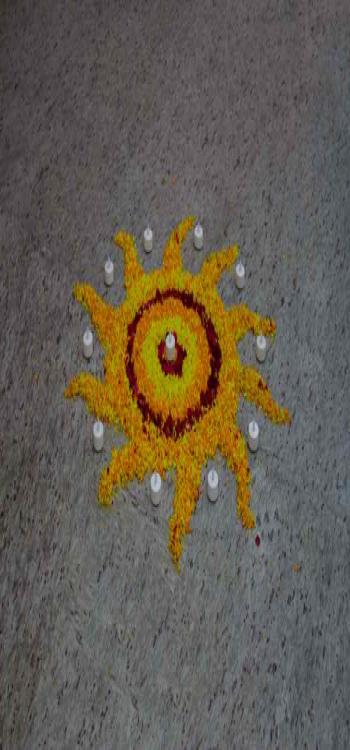
Another best rangoli design which is simple is of sun. It is said to represent energy, life and positivity. Therefore, it is often a welcoming gesture during festive occasions such as Diwali. Bright colours are used to create this design, making it one of the most eye-catching rangolis around.
Step-to-step guide to making The Sun Design.
- It is important to use bright colours for this design to represent the sun.
- Next, draw your outline. The sun design is typically a circle, but feel free to make it any shape you like.
- Once you have your outline, fill in the colours. Again, use bright colours to create an effect reminiscent of the sun.
- Finally, add the finishing touches. This may include adding rays emanating from the sun or other embellishments.
The Moon Design
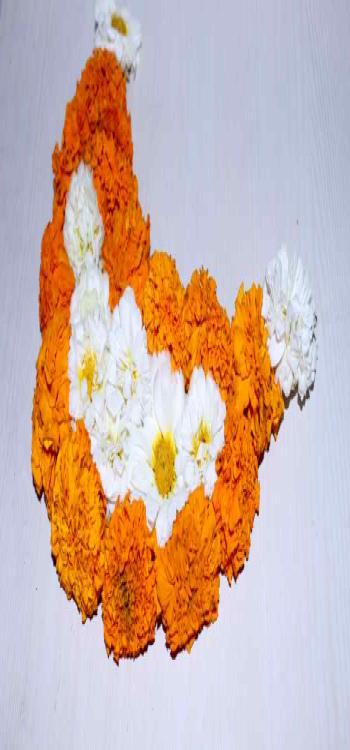
This is another small rangoli which can be colourful. The moon design symbolises peace and serenity. It is often used during religious festivals such as Eid and Bakra-Id. White powder or flower petals are typically used to create this design. The great thing about this is that it is an easy rangoli design for beginners and it can be as simple or complex as you like.
Step-to-step guide to making The Moon Design.
- To create a moon design, start by dotting a small circle in the centre of your chosen work surface.
- Connect each side of the circle using a straight line to form a crescent moon shape.
- Once your basic shape is created, you can start filling it in with colour.
- Use white or off-white tones for a more traditional look, but you can get creative with this part and use whatever colours you like.
- Once you have finished colouring your design, you can add finishing touches like outlines or patterns.
The Om Design

Om is the best small rangoli design which is a sacred sound and symbol in Hinduism that is often used as a mantra in meditation. It is also a popular design for rangoli, which are decorative patterns made with rice flour or sand on the floor. Making a rangoli of the Om symbol is a simple way to bring a touch of spirituality into your home.
Step-to-step guide to making The Om Design.
- Firstly, you must outline the Om symbol on your floor or surface. Then, you can use chalk, pencil or tape to help create a neat outline.
- Once you have the outline drawn, it’s time to start filling it in with your chosen material. For example, if you’re using rice flour, simply sprinkle it inside the lines of your drawing. For sand, you can use a small spoon or your fito and pour it into place carefully place.
- Once you’ve filled in the entire design, you can leave your rangoli as-is or add some extra decorations like flowers or candles around the outside.
The Ganesha Design
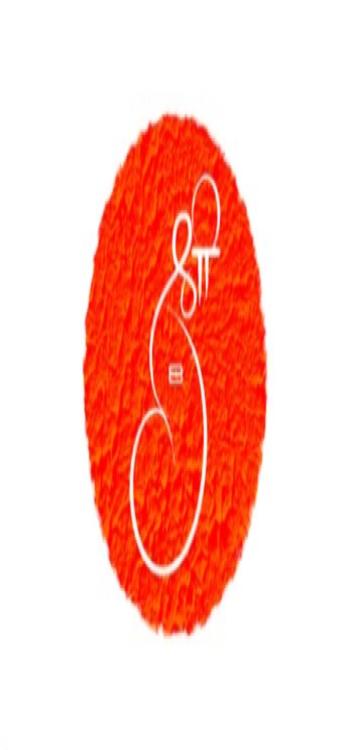
This is a colourful rangoli design which is simple as well to make. Ganesha is the Hindu god of wisdom and knowledge, making the Ganesha rangoli design very popular among Hindus. This design is said to represent good luck and prosperity. Various colours can create this rangoli, but red and yellow are considered especially auspicious.
The step-by-step guide to making The Ganesha Design
- Start by drawing a small circle in the centre of your chosen surface.
- Draw two curved lines from the circle’s top and bottom. These lines will form the trunk of Lord Ganesha.
- Next, add two small circles at the end of the trunk to form his hands.
- Finally, add details such as his eyes, nose, and mouth to complete the design.
The Swastika Design
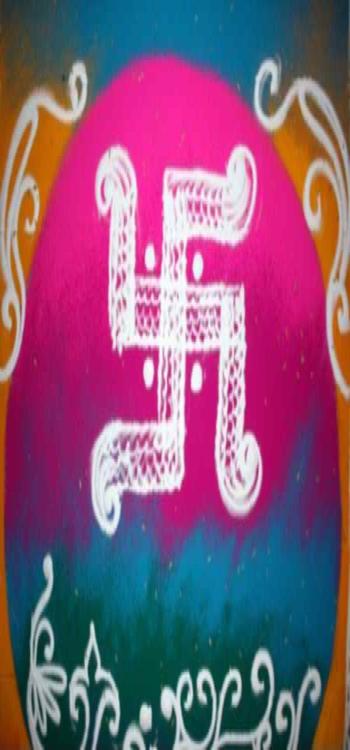
The swastika has a long history in Hinduism, representing good luck and well-being. As such, it is often used as a decorative motif in homes and temples across India. This rangoli design may be made with any colour, but red is very fortunate.
Step-by-step guide to making The Swastika Design.
There are many different ways to make a swastika design, but the most popular and simplest method is to use four straight lines.
- First, draw a square or rectangle on a piece of paper.
- Then, using a ruler, draw two diagonal lines from opposite corners of the square or rectangle.
- Finally, draw two more lines perpendicular to the first two lines so that all four lines intersect at the centre of the square or rectangle.
This basic swastika design can be modified in many ways to create different effects. For example, you can change the square or rectangle size or add additional lines or shapes to the design. You can also use different colours to create a more colourful design.
The Goddess Design
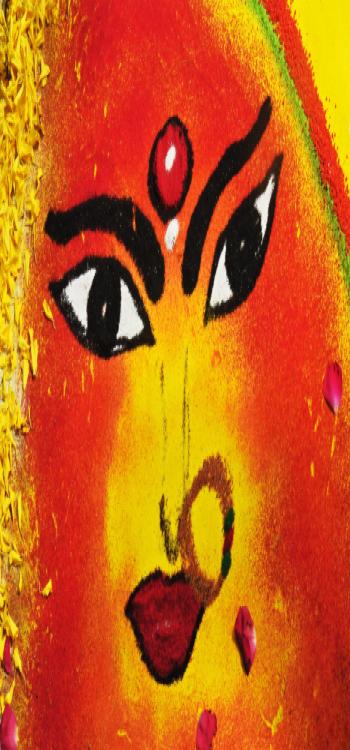
Rangoli designs can be simple or complex, and they are often created to celebrate special occasions like festivals and weddings. For example, the goddess design is a popular rangoli design that is often used to decorate homes during the festival of Diwali.
Step-to-step guide to making The Goddess Design.
- First, you will need to choose a colour scheme for your design.
- Next, you will need to create the outline of the goddess figure using rice or sand.
- Once the outline is complete, you can fill in the design details with colours.
- Finally, you will need to add finishing touches to your rangoli, such as embellishments or decorations.
Things Needed for Rangoli
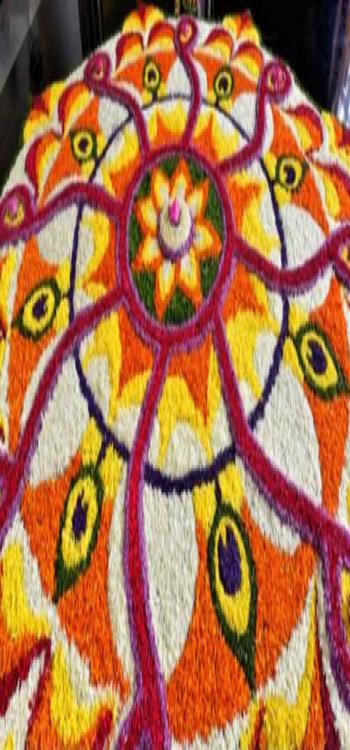
There are a few things you will need to make rangoli. The most important things are rangoli powder, which can be bought at any Indian grocery store, and a piece of paper or cardboard to use as a template. You will also need a bowl of water, a spoon, and something to draw with, like a pencil or pen.
To start, you will need to make a design on your paper or cardboard template. Once your design is ready, you can begin tracing it onto the ground with your rangoli powder. It is helpful to have someone else hold the template while you trace the design so it only moves a little bit.
Once you have traced your design onto the ground with the rangoli powder, you can start filling it in with colour. Wet your spoon in the water bowl and then dip it into the rangoli powder. Start outside the design and work until the entire design is filled in.
Once your design is complete, you can add finishing touches by drawing lines or patterns on top with a pencil or pen. You can also use different colours of rangoli powder to create different effects.
Some Design Tips to Follow
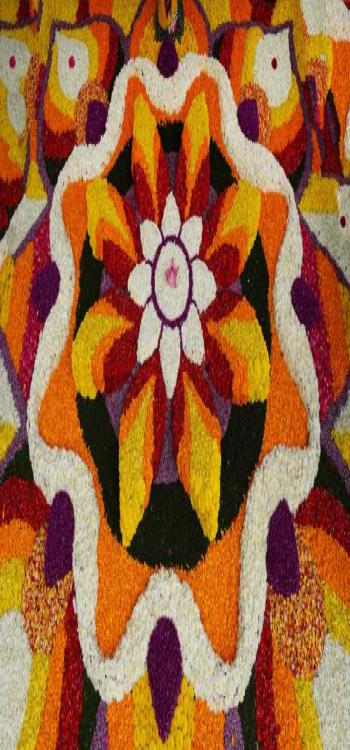
When it comes to rangoli designs, there are a few things to keep in mind to create something beautiful and unique.
- Consider the colours you want to use. Bright, contrasting colours will create a bolder look, while softer, complementary colours will create a more calming effect. You can also experiment with different colour combinations to see what looks best.
- Another thing to keep in mind is the size of your design. Rangolis can range from small and simple to large and complex. It all depends on how much time and effort you want to put into it. If you’re short on time, stick to something small and simple. You can go for something bigger and more detailed if you have more time.
- Finally, think about the overall shape of your rangoli. Most designs are symmetrical, but you can also play around with asymmetrical or abstract shapes for a more modern look.
Rangoli designs are a beautiful and popular way to decorate homes in India. Simple rangoli designs for home are also a great way to add a personal touch to your home décor. Rangoli designs can be simple or complex and can be created with various materials, including rice, sand, and colours.
Making a rangoli pattern is a wonderful way to customise the interior style of your house. Rangolis are a great addition to any house since they are also said to bring luck and wealth.
NoBroker is a simple, efficient way to find your perfect home. It is a one-stop solution for all your housing needs, whether finding a house on rent or buying one. With NoBroker, you can be assured of transparency and convenience in your search for the perfect home.
FAQs
Rangoli is a centuries-old Indian art form in which patterns are created on the ground using materials like flour, sand, rice, and flowers. The word “rangoli” comes from the Sanskrit word “rangavalli”, which means “row of colours”. Rangoli is usually drawn at a house or temple entrance as a welcoming gesture. It is also believed to bring good luck and prosperity.
To create captivating simple rangoli designs for the home door, consider using vibrant colours, symmetrical patterns, and adding floral motifs for a welcoming and decorative touch. Experiment with different colour combinations to make your rangoli stand out.
You can use a variety of materials for adding vibrant colours to your simple rangoli designs for home, including coloured powders, coloured rice, flower petals, and even coloured sand. Let your creativity flow with the medium that suits your preference and occasion.
To create a small eye-catching circle rangoli design, start with a central circle and build intricate patterns around it using vibrant colors and geometric shapes. Keep it symmetrical for an aesthetically pleasing look.
There are several stories and legends associated with rangoli. One popular legend tells the story of how Lord Krishna used to make beautiful rangolis for his friend, Radha. Another legend says that Lord Ganesha invented this art form to impress his mother, Parvati.













